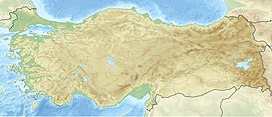Gergis, Troad
| Mount Ida Kazdağı, Turkey |
|
|---|---|

Location of Mount Ida on a map of the ancient Troad
|
|
| Highest point | |
| Elevation | 5,820 ft (1,770 m) |
| Prominence | At Karataş peak (ancient Gargarus) |
| Coordinates | 39°42′N 26°50′E / 39.700°N 26.833°ECoordinates: 39°42′N 26°50′E / 39.700°N 26.833°E |
| Geography | |
|
Balıkesir Province, Northwest Turkey
|
|
Mount Ida (Turkish: Kazdağı, pronounced [kazdaːɯ], meaning "Goose Mountain",Kaz Dağları, or Karataş Tepesi) is a mountain in northwestern Turkey, some 20 miles southeast of the ruins of Troy, along the north coast of the Gulf of Edremit. The name Mount Ida is the ancient one. It is between Balıkesir Province and Çanakkale Province.
Mount Ida is lightly populated upland massif of about 700 km² located to the north of Edremit. A number of small villages in the region are connected by paths. Drainage is mainly to the south, into the Gulf of Edremit, also known as Edremit Bay, where the coast is rugged and is known as "the Olive Riviera.". However, the Karamenderes River (the ancient Scamander) flows from the other side of Mount Ida to the west. Its valley under Kaz Dağları has been called "the Vale of Troy" by English speakers. Currently a modest 2.4 km² of Mount Ida are protected by Kaz Dağı National Park, created in 1993.
The summit is windswept and bare with a relatively low tree line due to exposure, but the slopes of this mountain, at the edge of mild Mediterranean and colder central Anatolian climate zones, hold a wealth of endemic flora, marooned here after the Ice Age. The climate at lower altitudes has become increasingly hot and dry in the deforested landscape. The dry period lasts from May to October. Rainfall averages between 631 and 733 mm per year. The mean annual temperature is 15.7 degrees Celsius, with diurnal temperatures as high as 43.7 degrees Celsius in Edremit. The forests on the upper slopes consist mainly of Turkish fir (Abies nordmanniana subsp. equi-trojani; considered by some botanists to be a distinct species Abies equi-trojani). Deer, wild boar and jackal are common at the area. Wolves, lynx, brown bears and big cats once roamed there, but now disappeared from the mountains due to overhunting.
...
Wikipedia

